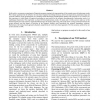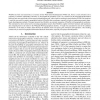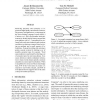108 search results - page 8 / 22 » Latent Semantic Word Sense Induction and Disambiguation |
LREC
2010
13 years 8 months ago
2010
In this article, we present an experiment of linguistic parameter tuning in the representation of the semantic space of polysemous words. We evaluate quantitatively the influence ...
LREC
2008
13 years 8 months ago
2008
WordNet has been used extensively as a resource for the Word Sense Disambiguation (WSD) task, both as a sense inventory and a repository of semantic relationships. Recently, we in...
ACL
2011
12 years 11 months ago
2011
Resolving polysemy and synonymy is required for high-quality information extraction. We present ConceptResolver, a component for the Never-Ending Language Learner (NELL) (Carlson ...
BMCBI
2010
13 years 7 months ago
2010
Background: Word sense disambiguation (WSD) algorithms attempt to select the proper sense of ambiguous terms in text. Resources like the UMLS provide a reference thesaurus to be u...
ICAI
2004
13 years 8 months ago
2004
This paper presents a new method for Word Sense Disambiguation based on the WordNet Domains lexical resource [4]. The underlaying working hypothesis is tha...



